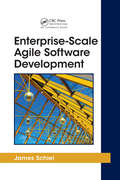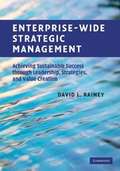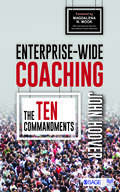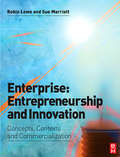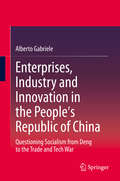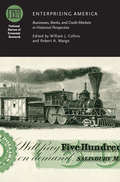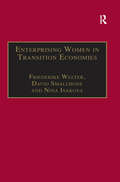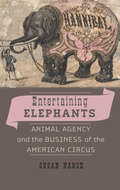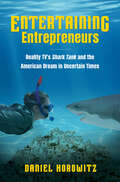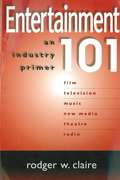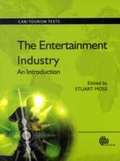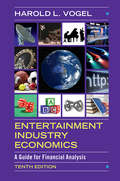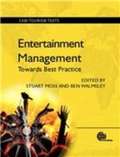- Table View
- List View
Enterprise, Money and Credit in England before the Black Death 1285–1349 (Palgrave Studies in the History of Finance)
by Pamela NightingaleThis book charts the contributions made to the development of the late medieval English economy by enterprise, money, and credit in a period which saw its major export trade in wool, which earned most of its money-supply, suffer from prolonged periods of warfare, high taxation, adverse weather, and mortality of sheep. Consequently, the economy suffered from severe shortages of coin, as well as from internal political conflicts, before the plague of 1348-9 halved the population. The book examines from the Statute Merchant certificates of debt, the extent to which credit, which normally reflects economic activity, was affected by these events, and the extent to which London, and the leading counties were affected differently by them. The analysis covers the entire kingdom, decade by decade, and thereby contributes to the controversy whether over-population or shortage of coin most inhibited its development.
Enterprise, Organization, and Technology in China: A Socialist Experiment, 1950-1971
by Philip ScrantonGiven the near-silence in technological and business history about post-World War II socialist enterprises, this book gives voice to a generation of Communist China’s managers, entrepreneurs, cadres, and workers from the Liberation to the early 1970s. Using recently-opened online archival resources, it details and assesses the course of technical and organizational experimentation at state-owned, cooperative, and private enterprises as the PRC strove to construct a socialist economy through trial-and-error initiatives. Core questions treated are: How did Chinese enterprises operate, evolve, experiment, improvise and adjust during the PRC’s first generation? What technological initiatives were crucial to these processes, necessarily developed with limited expertise and thin financial resources? How could constructing “socialism with Chinese characteristics” have helped lay foundations for the post-1980 “Chinese miracle,” as the PRC confidently entered the 21st century while Soviet and Central European socialisms crumbled? And what might current-day Western managers and entrepreneurs learn from Chinese practice and performance a half-century ago? Readers can anticipate a granular, bottom-up analysis of how businesses worked day-to-day in a planned economy, how enterprise practices and technological strategies shifted during the first postwar generation, how managers and technicians emerged after the capitalist exodus, how organizations experimented and adapted, and how the controversies and convulsions of the PRC’s early decades fashioned durable technical and organizational capabilities.
Enterprise-Architektur in der digitalen Welt: Zentrale Konzepte und Methoden für das EAM im agilen Projektalltag
by Hüseyin YükselWie schaffen Unternehmen die Transformation in die agile, innovative, digitale Geschäfts- und Arbeitswelt? Diese Frage treibt nicht nur IT-Manager, sondern auch die strategischen Akteure, die Enterprise-Architekten, um. Sie müssen den Spagat zwischen strategischer Planung und dem Umgang mit steigender Geschwindigkeit und wachsender Unsicherheit leisten. Eine ganzheitliche Unternehmensentwicklung in der digitalen Zukunft heißt, digitale Ökosysteme und komplexe IT-Landschaften zu entwickeln. In diesem Buch werden Methoden und Konzepte aus der agilen Welt, der Zeichentheorie und der Neuropsychologie vorgestellt, die dem Enterprise-Architekten im praktischen Alltag helfen können. Ausgehend von einem positiven Menschenbild kann es mit dem grundlegenden Wissen gelingen, das Potential von Individuen und Teams für den digitalen Wandel auszuschöpfen. Das Buch richtet sich vorwiegend an IT-Manager, Enterprise-Architekten und Manager im Umfeld von größeren Softwareentwicklungsprozessen.Viele praxisnahe Beispiele veranschaulichen die theoretisch dargestellten Zusammenhänge und eröffnen einen breiteren Zugang zum Enterprise-Architektur-Management.
Enterprise-Grade IT Security for Small and Medium Businesses: Building Security Systems, in Plain English
by Denny CherryUnderstand the IT security features that are needed to secure the IT infrastructure of a small to medium-size business. This book will give IT managers and executives a solid understanding of the different technology solutions that their business relies upon–or should be employing–in order to make reasoned decisions regarding the implementation of those features. Coverage includes multi-factor authentication, firewalls, zero-trust environments, network segmentation, remote access solutions, and the people aspects of security that are often overlooked and represent an organization’s biggest vulnerability. Chapters on the various technologies such as multi-factor authentication and zero-trust environments explain in plain English the values and benefits that each technology provides. Clear technical explanations are accompanied by business case explanations that explain the “why” of each technology and when each technology should be implemented. You will come away equipped to have business-driven discussions with your IT staff that allow for a productive balancing of the need for security with the need to do business and drive profits. You Will LearnThe importance of multi-factor authenticationThe limits of what multi-factor authentication can protectHow firewalls are used to protect your company from attackersWhat zero-trust environments are and what they meanWhether zero-trust networks are what is needed to secure your own environmentThe security benefits from implementing a network segmentation policyThe best ways to access files and resources from remote locations outside the officeWho This Book Is ForManagers and executives at small to medium-size businesses who want to understand the core aspects of IT security on which their business relies, business leaders who want to be able to follow along with and engage in discussions with IT professionals about security features, and leaders who are tasked with making decisions on which IT security features to implement
Enterprise-Scale Agile Software Development (Applied Software Engineering Series)
by James SchielEnterprise-Scale Agile Software Development is the collective sum of knowledge accumulated during the full-scale transition of a 1400-person organization to agile development-considered the largest implementation of agile development and Scrum ever attempted anywhere in the world. Now James Schiel, a certified Scrum trainer and member of the Scrum
Enterprise-Wide Strategic Management
by David L. RaineyIn today's highly competitive and dynamic business environments, corporations can no longer afford to rely on the static strategic management constructs of the past. Enterprise-wide Strategic Management is a leading-edge work that shows how business leaders can take better advantage of their opportunities by taking a broader perspective of the world in which they operate. David Rainey advocates a holistic approach to the business environment, arguing that managers must work with all stakeholders, both internal and external, to create long-term success. Including numerous case studies featuring global corporations and small- and medium-sized enterprises (SMEs), the book provides guidance and support in formulating, developing, and implementing business strategies and action plans. It also includes advice on how to develop and deploy strategic management systems, management constructs, and organizational structures. This gives executives, strategic leaders, professionals, and practitioners the tools they need to create value and achieve sustainable success.
Enterprise-wide Coaching: The Ten Commandments
by John J. HooverExecutive coaching is one of the most expensive investments organizations make in leadership development. Yet, conducting executive coaching engagements as individual, disconnected assignments with nothing to guarantee alignment, continuity, and cultural consistency is an expensive mistake at best. In Enterprise-wide Coaching, Dr John Hoover skillfully uses his decades of experience in consulting organizations and coaching individuals to suggest how and why coaching leaders should be aligned with organizational goals and must keep the voice and interests of the organization alive in all coaching engagements. The Ten Commandments will also help managers of coaching functions in organizations and the coaches they hire to design and structure organizational coaching engagements through an organization development lens. This will ensure that the coaches paid for by an organization for the purpose of developing, correcting, or enhancing management or leadership skills and behaviors in individuals and groups will work in tandem with the organization’s talent, leadership, and global business strategy, thereby producing maximum return on the coaching investment.
Enterprise: Entrepreneurship and Innovation
by Robin Lowe Sue MarriottEnterprise, Entrepreneurship and Innovation: Concepts, Contexts and Commercialisation provides readers with an accessible and readable introduction to the various dimensions of entrepreneurship and market innovation. It has a clear structure that is easy for the reader to follow and it focuses on enterprising behaviour. The text contains:* case studies and ‘pause and reflect’ situations for the entrepreneur to deliberate on the information they have available before making their decision. This helps to emphasise the point that there are few simple and straightforward decisions closely reflecting decisions in ‘real life’. * integrative personal development activities that provide a basis for readers to reflect on the learning of the chapters and develop a personal development strategy to increase their ability to become more entrepreneurial and improve their ability to manage market innovation. * an accompanying website giving students and lecturers access to additional resources in order to explore the subject further. A full set of powerpoint slides plus exercises is included, plus suggestions for the use in class of the case studies and other illustrations. Students can access further learning resources to build up their knowledge of innovation situations using the hotlinks to useful websites that will add further depth and bring up to date the case studies and illustrations. Enterprise, Entrepreneurship and Innovation: Concepts, Contexts and Commercialisation shows:* how to understand and acquire the entrepreneur’s skills, attitudes and knowledge* the techniques needed to generate new business and create a new organisation* how to become more innovative, self reliant, and opportunistic.* the learning and decision-making processes of entrepreneurs
Enterprise: Integrating Across Organizational Silos--Using Analytics to Improve Performance at All Levels of the Business
by Thomas H. Davenport Jeanne G. Harris Robert MorisonTo develop an enterprise-wide view of analytics, a company must do more than integrate data, combine analysts, or build a corporate IT platform. It must eradicate all of the limited, piecemeal perspectives harbored by managers with their own agendas, needs, and fears - and replace them with a single, holistic view of the company. Without a broad business perspective, a company cannot address the strategic issues at the core of business performance and organizational competitiveness. Analytics can illuminate high-level questions about investment optimization, company strategy alignment, customer satisfaction, market condition influence, and key performance factors, but only if decision makers can see across regions, business units, or processes and consider information from the enterprise perspective. In this chapter, the authors of the groundbreaking Competing on Analytics describe just how much integration and coordination are needed to develop an enterprise analytics capability and how to gauge your company's progress through the five stages of analytical mastery. This chapter was originally published as Chapter 3 of Analytics at Work: Smarter Decisions, Better Results.
Enterprises, Industry and Innovation in the People's Republic of China: Questioning Socialism from Deng to the Trade and Tech War
by Alberto GabrieleThis book analyses and critically evaluates the development of two key components of China’s economy: the network of productive enterprises, and the national innovation system, from the inception of market-oriented reforms to the present day. The approach is a partly novel one, albeit inspired to classical political economy, rooted in the structure and evolution of social relations of production and exchange and of the institutional setting in these two crucial domains. The main findings are twofold: First, the role of planning and public ownership, far from withering, has being upheld and qualitatively enhanced, especially throughout the most recent stages of industrial reforms. Second, enterprises are increasingly participating - along with universities and research centers - in a concerted and historically unparalleled effort to dramatically upgrade China’s capacity to engage in indigenous innovation. As a result, China’s National Innovation System has been growing and strengthening at a pace much faster than that of the national economy as a whole. The book also presents a speculative and provisional perspective on the validity, and meaning, of the claim that the country’s socioeconomic system is indeed a form of socialism with Chinese characteristics. It will be on interest to students and scholars researching China, politics, and development economics.
Enterprises’ Green Growth Model and Value Chain Reconstruction: Theory and Method
by Bin Jiang Qi Jiang Nengmin Wang Zhengwen HeThe goal of this book is to improve the ability of enterprises to implement the green growth model and value chain reconstruction. China’s environmental development strategies, such as carbon peak emission and carbon neutrality, have created new challenges and requirements for enterprises to “go green.” In addition, anti-globalization and the complex dynamic uncertainty caused by COVID-19 have changed the operational environment that enterprises face. The application of new technologies, including the new generation of information technologies and the whole process management technology, provides solutions for the implementation of enterprises’ green growth model and value chain reconstruction. Based on China’s enterprise management cases, this book reveals the connotative features of enterprises’ green growth model and their evolutionary regularities, the overall framework and decision optimization of value chain reconstruction under the green growth model, and the approach to implementing the green growth model and value chain reconstruction. The theoretical framework of the green growth model and value chain reconstruction established in this book has enriched and developed the research results in this field. Cases of enterprises implementing the green growth model can provide references for the green transformation of enterprises and help enterprises appreciate the synergy between sustainability and growth. This book can also serve as a research reference for scholars engaged in the field of sustainable operations, as well as decision-makers and managers of relevant government departments.
Enterprising Africa: Transformation through Entrepreneurship
by Stephen Dobson, Paul Jones, Daniel Agyapong and Gideon MaasEnterprising Africa explores the future opportunities, challenges, growth areas and key themes that will shape entrepreneurship in the African continent over the next decade. Entrepreneurship can be the key to unlock resilient growth, but only if it is driven by both socially productive and growth-oriented new businesses. The book considers entrepreneurship as an enabler for socio-economic growth and development in Africa, especially in the context of youth unemployment and increasing youth population for which the traditional, and indeed emerging, industrial sectors will not be able to produce sufficient jobs to meet demand. Organised around three thematic parts, Part I covers the notion of inclusive growth and the role that entrepreneurs can play supporting this. Part II considers the dynamic between entrepreneurs and the environment since social, economic and environmental concerns need to build upon each other rather than vie for recognition. Finally, Part III offers chapters exploring policy contexts and the wider institutional ecosystems that need to be developed and enhanced to ensure a strong and vibrant environment for the future entrepreneurs of Africa to thrive. Edited and authored by leading experts in the field, this fascinating text will be of interest to academics as well as students of International, Transformational and Social Entrepreneurship, and International and African Business.
Enterprising America
by Robert A. Margo William J. CollinsThe rise of America from a colonial outpost to one of the world's most sophisticated and productive economies was facilitated by the establishment of a variety of economic enterprises pursued within the framework of laws and institutions that set the rules for their organization and operation. To better understand the historical processes central to American economic development, Enterprising America brings together contributors who address the economic behavior of American firms and financial institutions--and the associated legal institutions that shaped their behavior--throughout the nineteenth and early twentieth centuries. Collectively, the contributions provide an account of the ways in which businesses, banks, and credit markets promoted America's extraordinary economic growth. Among the topics that emerge are the rise of incorporation and its connection to factory production in manufacturing, the organization and operation of large cotton plantations in comparison with factories, the regulation and governance of banks, the transportation revolution's influence on bank stability and survival, and the emergence of long-distance credit in the context of an economy that was growing rapidly and becoming increasingly integrated across space.
Enterprising Education in UK Higher Education: Challenges for Theory and Practice (Routledge Studies in Entrepreneurship)
by Gary Mulholland Jason TurnerThe UK may be ranked as one of the best countries in the world to start a business, but evidence from growing skills gaps, and the decline in graduates’ entrepreneurial aspirations suggest that higher education may not be contributing as it should to the enterprise environment. Enterprising Education in UK Higher Education brings together the challenges of embedding enterprise education in universities and colleges, identifies current debates around their roles and explores research, theory and practice to deliver roadmaps for innovative enterprise education. This book provides solid and clear guidance to practitioners and academics who are starting their journey into enterprising education, as well as those who are more experienced, but understand that the traditional approaches limit the options of future graduates. It collates the theory and practice of enterprise education in the UK higher education sector and business engagement with wider stakeholders. Drawing on theory and best practice, and illustrated with a wide range of the examples and cases, it will provide invaluable guidance to researchers, educators, practitioners and policy makers.
Enterprising Initiatives in the Experience Economy: Transforming Social Worlds (Routledge Studies in Entrepreneurship)
by Britta Timm Knudsen Dorthe Refslund Christensen Per BlenkerOver the last decade, the close relationship between culture and economy - or "the experience economy" – has risen on the agenda. Although there is an established research field for analysing the economic impact of entrepreneurship, there is currently a limited amount of research that analyses the cultural impact and opportunity of entrepreneurship. Linking experience economy with enterprising behavior moves the term away from businesses' competitiveness and consumer behavior towards a more value-focused business in general. This ground-breaking book integrates entrepreneurship and empowerment into one central theme, drawing on research from both the social sciences (innovation, entrepreneurship, empowerment and activism) and the humanities (participatory culture, user-generated designs, creative networks). Enterprising Initiatives expands the definition of entrepreneurship beyond a primarily economic profit-seeking phenomenon to a broader understanding of enterprising behaviour based on an individual-opportunity nexus. Beyond social entrepreneurship, it explores a broad range of individual, collective and cooperative citizen initiatives under the umbrella of enterprising action. This innovative approach will be of great interest to scholars in entrepreneurship, social entrepreneurship, cultural entrepreneurship, cultural studies, and consumer culture, as well as for policy makers in public and local government, regional development and cultural event management.
Enterprising Psychometrics and Poverty Reduction
by Carlos Del Carpio Bailey Klinger Asim Ijaz KhwajaThis book uses newly collected data with nearly 2000 observations across Africa and Latin America of SME owner/operators to examine if psychometric tools can distinguish the good ones from the bad ones. This book fully describes the development problem and how psychometric tools can help solve it. Moreover, it presents and develops the unique statistical methodologies to deploy psychometric tools for credit screening. This will be the single complete publication of the work to date by the entrepreneurial finance lab, created by Klinger & Khwaja. This work started as a research project at Harvard University's center for international development, with funding from Google.org. This work is very high profile, winning the G-20 SME Finance Challenge in 2010 (global open competition to identify the best scalable solutions to unlocking SME finance- winners honored at the G-20 summit in Seoul Korea and receiving significant funding from G-20 countries for the implementation of their models).
Enterprising Women in Transition Economies
by David SmallboneEntrepreneurship is a key element in the development of market based economies and one of the potential drivers of change in countries that are in the process of transformation to market based systems. This book describes and critically assesses the nature and extent of female entrepreneurship in European economies that until 1990 were operating under central planning. At the core of the book are 7 country based chapters which provide an overview of the development of entrepreneurship and small firms since 1990, including a review of the institutional and policy context; an assessment of the role of women within the society during the socialist period; and any major changes afterwards. Each chapter also includes a thematic section (each one addressing a different issue) based on unique empirical data drawn from original research.
Entertaining Elephants: Animal Agency and the Business of the American Circus (Animals, History, Culture)
by Susan NanceHow the lives and labors of nineteenth-century circus elephants shaped the entertainment industry.Consider the career of an enduring if controversial icon of American entertainment: the genial circus elephant. In Entertaining Elephants Susan Nance examines elephant behavior—drawing on the scientific literature of animal cognition, learning, and communications—to offer a study of elephants as actors (rather than objects) in American circus entertainment between 1800 and 1940. By developing a deeper understanding of animal behavior, Nance asserts, we can more fully explain the common history of all species.Entertaining Elephants is the first account that uses research on animal welfare, health, and cognition to interpret the historical record, examining how both circus people and elephants struggled behind the scenes to meet the profit necessities of the entertainment business. The book does not claim that elephants understood, endorsed, or resisted the world of show business as a human cultural or business practice, but it does speak of elephants rejecting the conditions of their experience. They lived in a kind of parallel reality in the circus, one that was defined by their interactions with people, other elephants, horses, bull hooks, hay, and the weather. Nance’s study informs and complicates contemporary debates over human interactions with animals in entertainment and beyond, questioning the idea of human control over animals and people's claims to speak for them. As sentient beings, these elephants exercised agency, but they had no way of understanding the human cultures that created their captivity, and they obviously had no claim on (human) social and political power. They often lived lives of apparent desperation.
Entertaining Entrepreneurs: Reality TV's Shark Tank and the American Dream in Uncertain Times
by Daniel HorowitzThe Great Recession threatened the well-being of tens of millions of Americans, dramatically weakened the working class, hollowed out the middle class, and strengthened the position of the very wealthy. Against this backdrop, the hit reality show Shark Tank premiered in 2009. Featuring ambitious entrepreneurs chasing support from celebrity investors, the show offered a version of the American Dream that still seemed possible to many, where a bright idea and a well-honed pitch could lift a bootstrap business to new heights of success. More than a decade later, Shark Tank still airs regularly on multiple networks, and its formula has sparked imitators everywhere, from elite universities to elementary school classrooms. In Entertaining Entrepreneurs, Daniel Horowitz shows how Shark Tank's version of entrepreneurship disguises and distorts the opportunities and traps of capitalism. Digging into today's cult of the entrepreneur, Horowitz charts its rise from the rubble of economic crisis and its spread as a mainstay of American culture, and he explores its flawed view of what it really takes to succeed in business. Horowitz offers more than a look at one television phenomenon. He is the perfect guide to the portrayal of entrepreneurship in business school courses, pitch competitions, popular how-to books, and scholarly works, as well as the views of real-world venture capitalists.
Entertainment 101
by Rodger W. Claire Jeffrey HirschEntertainment 101 provides an overview of the rapidly changing entertainment industry: Who does what, how, when and why in the making and marketing of America's most influential and profitable export. A street-smart primer, this book demystifies and explains the terminology and inner workings of the entire industry, covering motion pictures, television, theatre, music and new media. This up-to-the-minute manual is an essential desktop reference for students and entertainment business veterans alike, or indeed anyone fascinated by an industry that intrigues most of us and has a profound effect on our society. To simplify things, we have divided the far-flung and variegated entertainment industry into its six principle businesses: film, television, music, new media, theater and radio. To help understand how a project is actually created and to identify the players in each medium, we have listed the typical cast and crew credits from a film, a television show, a record album, a stage play, an on-line magazine and a radio show. We have described in detail the jobs of each artist and artisan and what they contribute.
Entertainment Industry
by Stuart Moss Ben Walmsley Nigel Morpeth Rebekka Kill Marc Etches Nicola Mccullough Laura Taylor Alexandra Kenyon Volker Rundshagen Penelope Griffiths Stephen Henderson Phil Clements Erika Pearson James RobertsEntertainment studies are an important emerging subject in tourism, and this introductory textbook provides a detailed overview of the entertainment industry discipline in order to prepare students for roles such as promoters, festival managers and technical support workers. Covering key aspects of entertainment by profiling individual sectors, each chapter is written by an expert working in the field and covers the history and background, products and segmentation, contemporary issues, micro and macro business, environmental influences, detailed case studies and future directions of that sector. It will be an essential text for undergraduate students in entertainment management, events management and related tourism subjects.
Entertainment Industry Economics
by Harold L. VogelThe entertainment industry is one of the largest sectors of the U. S. economy and is in fact becoming one of the most prominent globally as well, in movies, music, television programming, advertising, broadcasting, cable, casino gambling and wagering, publishing performing arts, sports, theme parks, toys and games. The eighth edition of Entertainment Industry Economics differs from its predecessors by inclusion of a new section on the legal aspects and limitations common to all such 'experience' industries, reference to the emerging field of the psychology of entertainment, partial restructuring and expansion of the music chapter, enhancement of the section on advertising, and broadening of the coverage in the gaming and wagering chapter. The result is a comprehensive, up-to-date reference guide on the economics, financing, production and marketing of entertainment in the United States and overseas, that will interest investors, business executives, accountants, lawyers and arts administrators.
Entertainment Industry Economics: A Guide for Financial Analysis
by Harold L. VogelAlready among the most important sectors of the US economy, the entertainment and media industries are continuing to grow worldwide. Fully updated, the tenth edition of Entertainment Industry Economics is the definitive reference on the economics of film, music, television, advertising, broadcasting, cable, casinos, publishing, arts and culture, performing arts, toys and games, sports, and theme parks. Its synthesis of a vast amount of data provides an up-to-date guide to the economics, financing, accounting, production, marketing, and history of these sectors in the United States and countries across the globe. This edition offers new material on streaming services, the relationship between demographics and entertainment spending, electromagnetic spectrum for broadcasters, and revised FASB accounting rules for film and television. Financial analysts and investors, economists, industry executives, accountants, lawyers, regulators, and journalists, as well as students preparing to join these professionals will benefit from this invaluable source.
Entertainment Management
by Stuart Moss Ben WalmsleyFollowing on from The Entertainment Industry: An Introduction, Entertainment Management takes the next step in the development of entertainment as a practice and as an academic subject. Aimed at higher level undergraduates, the book discusses best practices in the entertainment industry, profiling a different discipline per chapter, each one a branch of entertainment that offers employment opportunities within the sector. Fields include marketing, P.R., the media, live events, artist management, arts and culture, consultancy and visitor attractions. The book aims to reflect the knowledge students will need for real world of entertainment management such as technical standards, business management, people management, economic aspects and legal issues. Each chapter discusses the background of the discipline, best practice management principles, issues in the wider environment, case studies of real organisations and future trends.
Entertainment Media in Indonesia
by Mark Hobart and Richard FoxEntertainment media now comprise one of the worlds largest industries, yet they remain one of the least studied aspects of contemporary mass media. Every day hundreds of millions of people watch television programs that might broadly be described asentertainment notably in the rapidly developing countries of Asia. However we still have little




